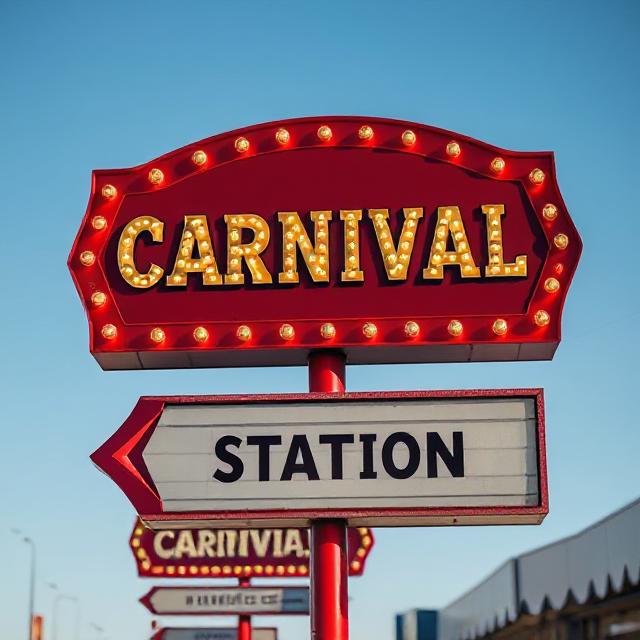Introduction to Carnival Station Signs
Carnivals are vibrant celebrations filled with color, music, laughter, and a sense of community. At the core of these lively events are the carnival station signs—small but vital elements that facilitate movement, enhance the aesthetic appeal, and contribute to the overall experience of the festivities. These signs serve as both functional guideposts and decorative accents, creating an environment that is welcoming, organized, and engaging for visitors of all ages.
The Role and Importance of Carnival Station Signs
In any large-scale event like a carnival, effective navigation is crucial. With numerous attractions—rides, game booths, food stalls, rest areas, and entertainment zones—attendees can easily feel overwhelmed or disoriented without clear guidance. Carnival station signs address this challenge by providing direction and information, helping visitors find their way effortlessly.
Beyond navigation, signs also play a significant role in setting the tone and theme of the carnival. Well-designed signage enhances the visual appeal, making the event more immersive and memorable. They can reflect the theme—be it vintage, circus, fantasy, or cultural—and integrate seamlessly into the overall aesthetic.
Types of Carnival Station Signs
- Directional Signs: These are the most common, guiding visitors to major attractions such as rides, food courts, restrooms, and entrances/exits. They typically feature arrows, icons, or symbols, making them understandable even across language barriers or for children.
- Informational Signs: These provide essential details, such as ride height restrictions, safety instructions, schedules for performances, or rules for specific areas. Clear, concise information ensures safety and enhances the visitor experience.
- Decorative and Thematic Signs: Designed to match the carnival theme, these signs add visual flair. For instance, a vintage carnival might feature ornate, hand-painted signs, while a fantasy-themed event could have signs designed as scrolls or magical runes.
- Promotional Signs: These highlight special offers, upcoming shows, or featured attractions. Bright, eye-catching posters and banners attract attention and encourage participation.
- Wayfinding and Zone Signs: Large signs that segment the carnival into zones—kids’ area, thrill rides, food court, games—help visitors orient themselves and plan their route.
Design Elements of Effective Carnival Station Signs
The effectiveness of carnival signs depends heavily on design. Several elements contribute to creating signs that are both functional and attractive:
- Color: Bright, contrasting colors catch the eye and can be used to differentiate zones or types of information. For example, red for warning or safety, green for directions, and yellow for attractions.
- Icons and Symbols: Universal symbols—such as a fork and knife for food, a wheelchair for accessibility, or a roller coaster for rides—communicate quickly and effectively across language barriers.
- Typography: Bold, legible fonts ensure readability from a distance. The font style should match the theme—playful, vintage, modern—to maintain aesthetic consistency.
- Materials: Weather-resistant materials like corrugated plastic, wood, or metal ensure durability outdoors. Illuminated signs or LED displays can be used for nighttime visibility.
- Size and Placement: Signs should be appropriately sized for visibility without overwhelming the environment. Strategic placement—at eye level or at decision points—guides visitors naturally.
Innovative Trends in Carnival Station Signs
With advancements in technology and design, carnival signs are evolving beyond traditional static signs:
- Digital Signage: LED screens can display dynamic content, such as schedules, alerts, or live updates, making information timely and engaging.
- Interactive Signs: Touchscreens or augmented reality features allow visitors to access detailed maps, participate in games, or receive personalized directions.
- Themed Signage: Incorporating elements like caricatures, mascots, or themed motifs enhances storytelling and creates a cohesive visual narrative.
Challenges and Considerations
Designing carnival station signs involves balancing aesthetics with practicality. Some challenges include:
- Weather Conditions: Signs must withstand sun, rain, wind, and occasional vandalism.
- Language Diversity: In multicultural settings, multilingual signs or universally understood symbols are essential.
- Crowd Management: Signs should minimize congestion; placing multiple signs at key points prevents bottlenecks.
- Safety Regulations: Clear signage for emergency exits and safety instructions is non-negotiable to ensure attendee safety.
Conclusion
Carnival station signs are more than mere markers; they are integral components that shape the attendee experience. When thoughtfully designed, they blend functionality with creativity, guiding visitors seamlessly while enriching the visual landscape of the event. As carnivals continue to evolve, so too will their signage—embracing new technologies and design philosophies to ensure that every visitor’s journey is safe, enjoyable, and memorable. Whether through whimsical illustrations, bright colors, or innovative digital displays, carnival station signs remain the heartbeat of festive navigation, ensuring that the spirit of celebration flows smoothly from start to finish.



